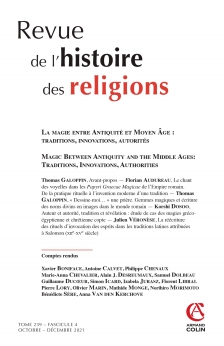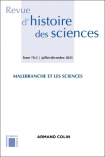
REVUE DE L'HISTOIRE DES RELIGIONS (4/2021)
Pour acheter ce numéro, contactez-nous
Recevez les numéros de l'année en cours et accédez à l'intégralité des articles en ligne.
Au début du xxe siècle s’est imposée l’image d’Épinal du magicienastrologue. Selon une logique pythagoricienne, celui-ci emploierait la musique pour évoquer les pouvoirs astraux des planètes, et les voyelles que l’on retrouve dans les papyrus de magie gréco-égyptienne serviraient à écrire les notes de la gamme classique. Or, cette « tradition » est avant tout historiographique et ne rend pas compte des pratiques et des dynamiques d’accommodation culturelle. L’analyse détaillée du corpus révèle en effet que l’interprétation astrologique ne relève pas d’une tradition, mais d’une invention ponctuelle et ciblée. C’est au contraire une logique propre aux magi qui sous-tend l’utilisation des voyelles : elles incarnent la puissance du souffle (πνεῦμα) et sa capacité à produire des sons.
At the beginning of the nineteenth century, there was a cliché circulating according to which magicians were also experts in astrology. Some were reported to have used music to summon astrological powers through the planets, based on a Pythagorean tradition, and the vowels that we find in the Graeco-Egyptian magical papyri were said to record the musical scale. Yet this “tradition” is primarily a matter of historiography and does not match with the practices and dynamics of cultural accommodation. A detailed analysis of the corpus reveals that the astrological interpretation does not derive from a Greek philosophical tradition but is rather a specific and targeted invention. It is therefore necessary to look at this practice from an emic perspective: vowels are occasionally linked with planets but they essentially stand for the power of breathing (πνεῦμα) and its capacity to produce sounds.

